Currumbin Wildlife Sanctuary
April 6, 2011
We admired the view from our 42nd floor apartment for one last time in the morning before we packed everything and headed for the Currumbin Wildlife Sanctuary. When Helene and I was in Australia 2 years ago we went to the sanctuary and agreed that we had to bring the kids there during the voyage.
The sanctuary has a very impressive collection of Australian wildlife and a large open area where some of the animals, including a large number of kangaroos, roam freely. You can enter the area and walk around in parts of it. Even better, you can buy kangaroo food and they will eat from your hands. The kids absolutely loved it.

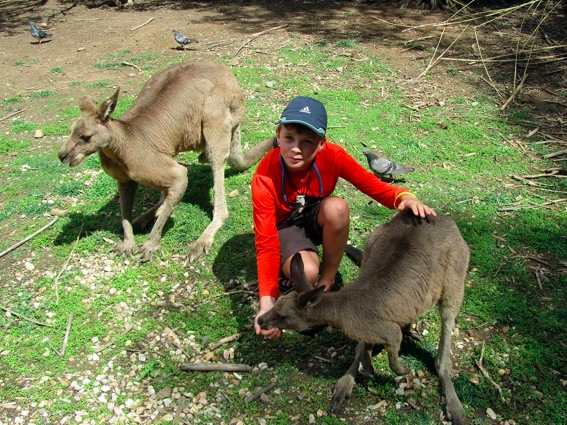
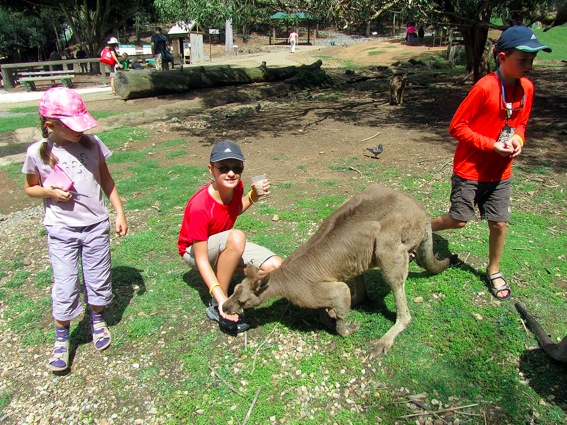
Kangaroos know the art of relaxing:

There was a separate area where kangaroos who wanted to take a break from all the intense human interaction could chill out:
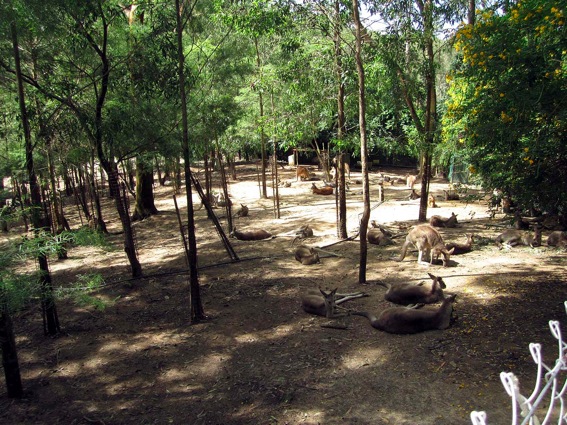
We also saw the very rare hose-eating emu:

Here is a cassowarry, which we also saw in Sydney. This photo was taken through a fence. Dangerous as they are, these birds do not live in the open area:

These flightless birds are found in New Guinea and northern Australia. The normal adult size is about 1.7 meters (5 foot 7″), but some have reached over 2 meters (6 foot 7″) and over 60 kg (130 pounds). The cassowary is the second heaviest bird in the world, after the ostrich.
Cassowaries are very antisocial birds. They seem to despise being with their own species. In the wild they only meet once a year to mate, and then only on a one-on-one basis. Kids flee the home as soon as they are big enough to fend for themselves.
Male cassowaries keep a territory of about 7 square km (2.7 square miles), which they fiercely defend against other males. In mating season they prepare heaps of leaves for the eggs. If a male is lucky a female comes to breed and lays 3 to 5 eggs on the heaps. Once she has had her one-night stand (actually it lasts a few days, but the concept is the same) she says “Hasta la vista, baby!” and moves on to find another male she can leave with some screaming kids.
The male then incubates the eggs (takes about 2 months) and cares for the little ones for 9 months. The kids then leave the nest and the new young males start looking for a territory they can call their own.
These birds are an endagered species and there are only about 1500 of them left in Australia. Their rainforest habitats have been destroyed and only about 20-25% of their original habitat remains.
Cassowarys are very important seed propagators because of their bizarre eating habits. Although they are omnivores they mostly live off fruit. They have taken the concept of only eating non-processed food to its logical extreme. These birds refuse to eat anything but whole fruit, and chewing is a no-no (fair enough when you have no teeth, I guess). Yes, the cassowary swallows everything whole, including bananas and apples (when they can get them).
Some seeds actually only germinate once they have passed through a cassowary’s digestive system. Scientists examining cassowary poo (what a job!) have identified over 300 different seed types in their dung. If the cassowary disappears many types of trees will have a harder time to reproduce and survive.
These birds are considered to be the most dangerous birds in the world. They are very shy, but once they feel threatened they will attack with ferocity. They will go at you with speeds of up to 50 km per hour (30 mph) and can jump over a meter (3 feet) into the air with their dagger-like claws first, presumably in a Bruce-Lee-like karate position. “Hay-yah! Take that, human.”
The list of coolness factors for these birds seems to never end. They communicate with each other using very low frequency booming sounds, barely audible to humans. Low frequencies are ideal for communication between solitary walking birds over large distances of rainforest.
They are also very efficient swimmers and have been seen while sprinting across rivers.
Iseline carried her drawing pad and made this drawing of a cassowary for me:
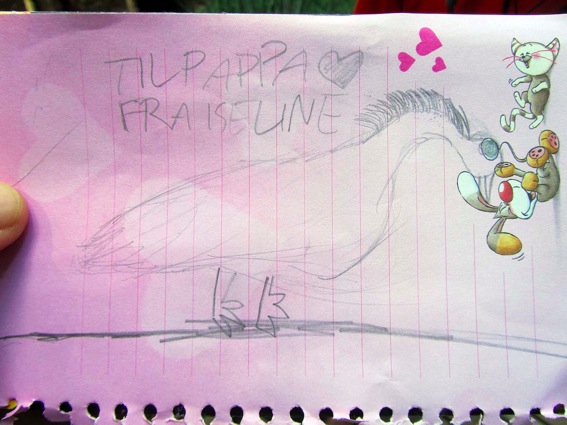
We also saw some pretty impressive crocodiles:
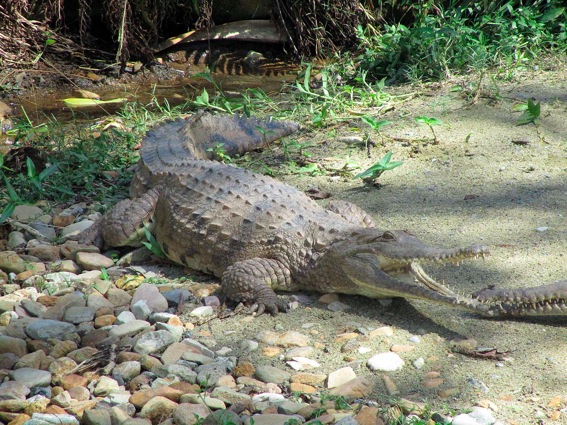

We attended a really cool live bird show. This guy had free-flying birds fly to and from him all the time, telling us about the different species. Several of the birds also performed tricks:
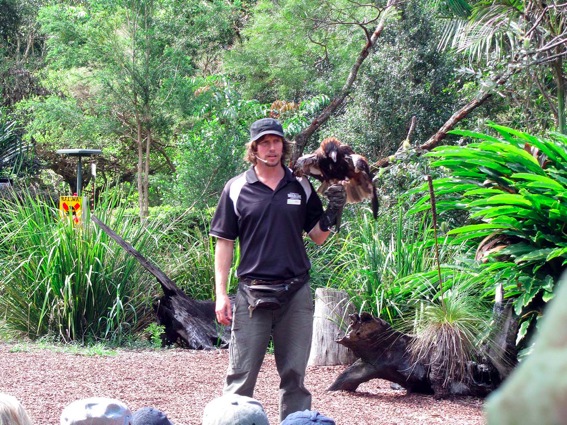
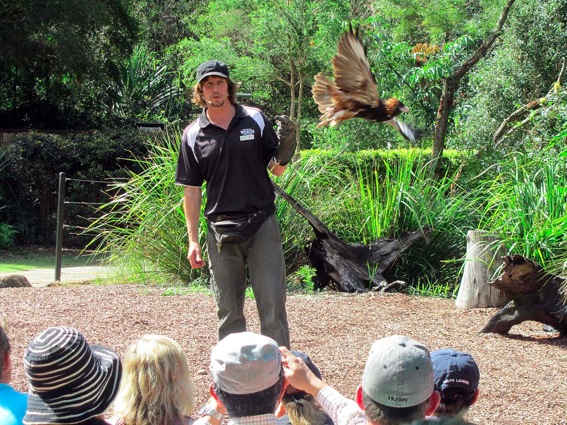
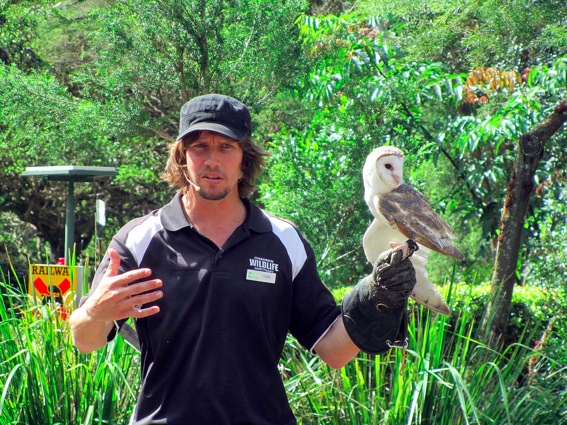
One of the falcons refused to fly today, everyone can have a bad day, I guess. It was fetched by this woman who showed it to us anyway.
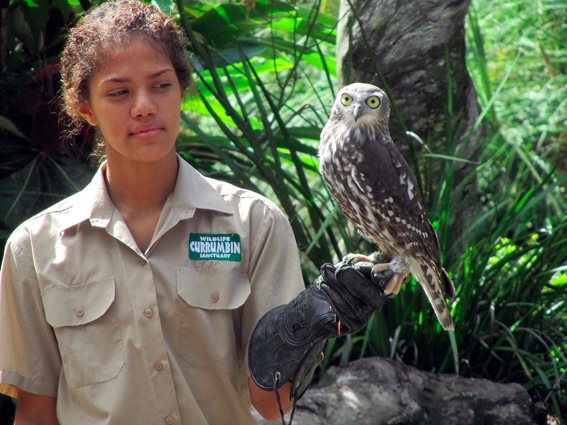
Some of the birds did a pit stop on a branch before flying all the way to the presenter. Eagle:
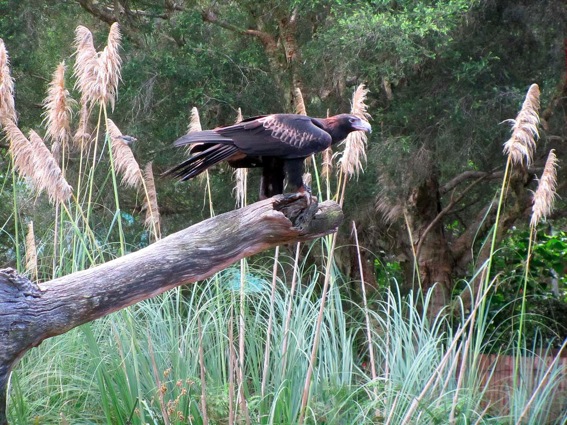
Macaw:
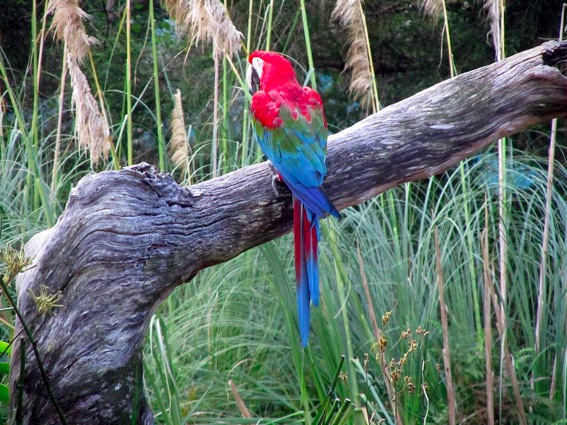
Cockatoo:
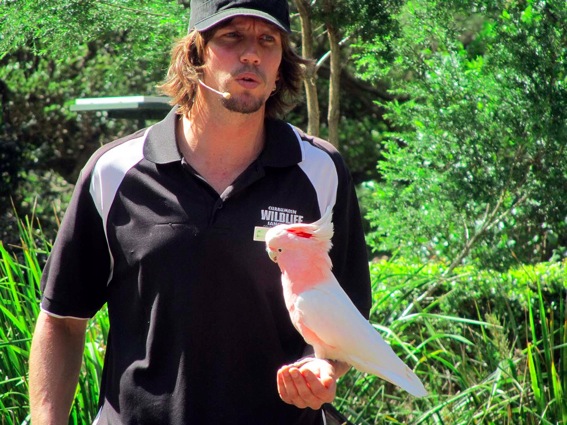
It was a great kid-friendly show. Highly recommended.
We had bought all-inclusive day-tickets and signed up for the “green challenge adventure park” course at the end of our stay. Once again the entire family had to dress up. This time we looked more like prisoners than teletubbies:

The course was an obstacle course halfway up the rainforest trees. It’s not every day that you get to walk on a tightrope 5 meters (16 feet) or more above the ground. The kids were in heaven.



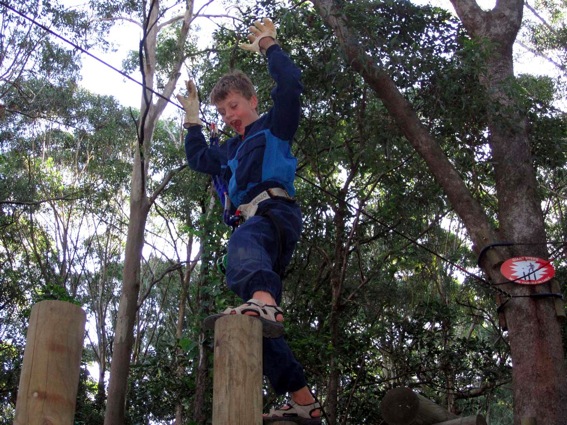
Those who were members of AA (Acrophobians Anonymous) held on tighter than the others:
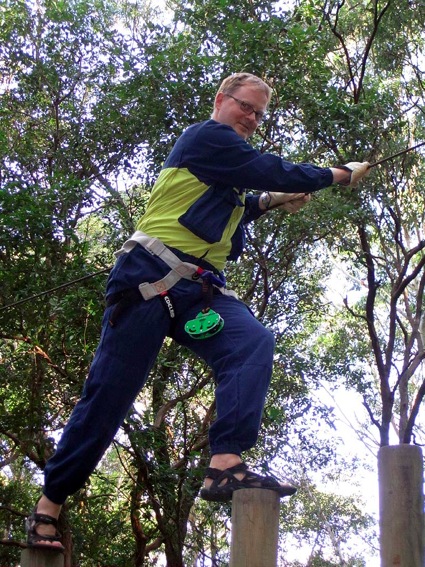

At the very end there was a long zipline where we attained impressive speeds. The zipline ended in a tree and the constructors of the course obviously saw no need to limit the possible speed. This is Australia, after all, and not the US. If you get hurt, not even the best lawyer can get you a dime in compensation. You did it, you take the consequences.
I was so focused on containing my fear of heights at the end that I did not pay enough attention to the rapidly approaching tree. I smashed into it, full force. Luckily they had figured out that not all tourists are able to look after themselves, so they had padded it with rubber foam. My head bumped into the padding and my left eye created a beautiful imprint on my glasses. Look at this work of art:

Once finished we just had time to run over for the big event, the famous lorikeet feeding. The foundation for the sanctuary was serendipitously laid when, in 1947, flower grower Alex Griffiths started to feed the lorikeets in the area to keep them away from his flowers. The daily feeding of massive amounts of these colorful and beautiful birds soon became a local attraction.
The feeding is stil going on and the birds are now fed twice daily, at 8am and 4pm. These are not tame birds, but wild free-flying lorikeets.
We received a pan each, which was filled with artificial nectar. Then we waited, and waited, and waited some more. The employees at the park assured us that the birds would arrive. They know when it is feeding time. Iseline found the wait difficult to bear:

Then, suddenly, we could hear them. Hundred of birds chirped in cacophony, first very distant, then closer and closer. They started swirling in the air above us and the doppler effect created cool sound effects of pitch-changing bird sounds. Some of the lorikeets landed in a nearby tree.

And some came over and started the party. Unfortunately the birds came from above and landed on the pans that were held highest. None came to Iseline:

Mom, it’s not fair. The birds don’t love me.

Don’t cry, my little sweetheart, I can hold your pan up high for a while and get you a bird. Look, here it is already:

She got a couple more, which came all by themselves, and she was happy again:
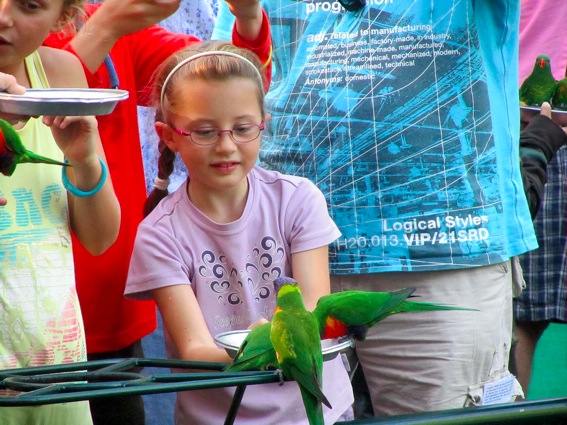
The birds were not very afraid of us and used all possible landing areas to get to the nectar:

Pans were refilled all the time. The birds must have been around for about half an hour:
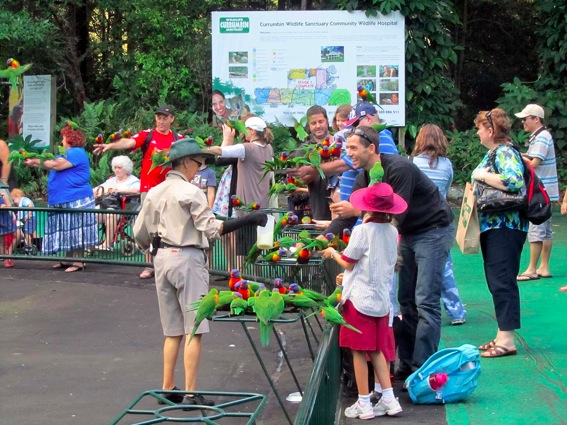
Even lorikeets can be heavy, given enough of them:
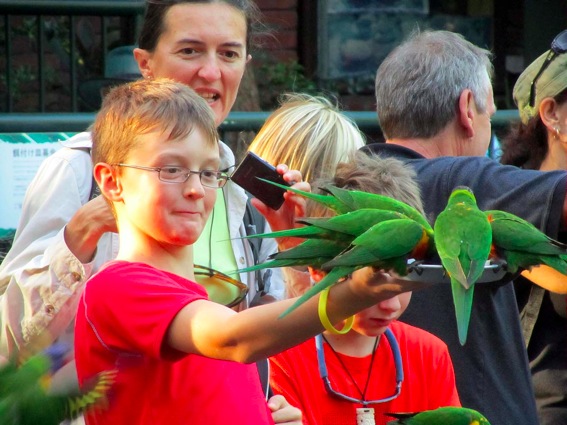
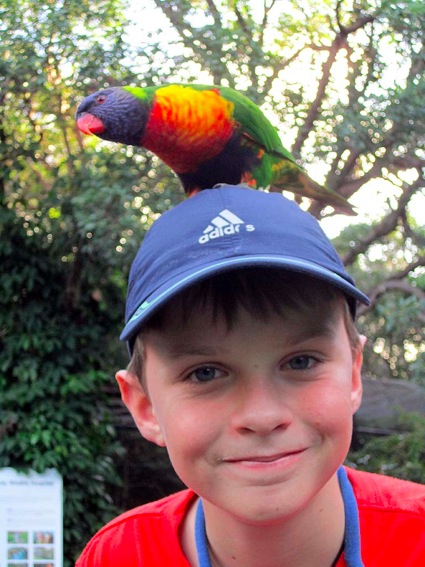


We were glad we had decided to only do the sanctuary today. There were so many things to see and do. We could easily have spent even more time there. Going through the photos of the day I realized that we were starting to get a little lazy and tired of photographing all the time. We saw many more animals, including platypuses, echidnas and tree kangaroos, but alas, you do not get to see them.
We drove over to Brisbane and Sharon and Warwick’s place. They had been kind enough to invite us to stay at their place for a week. We were looking forward to some calm Australian family life.
When we arrived an envelope from Melbourne was waiting for Iseline. She was very happy to have her iPod Touch back again:
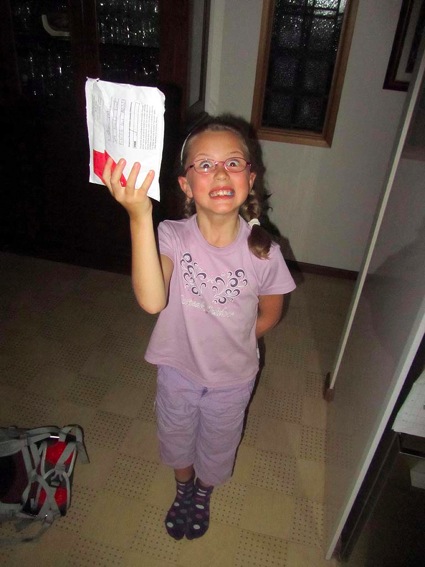
So happy, in fact, that she became partly transparent:

Eirik
—–





love the beautiful and fun pics of everyone enjoying themselves!
hal
Nice trick Iseline! Maybe you can teach Emily…